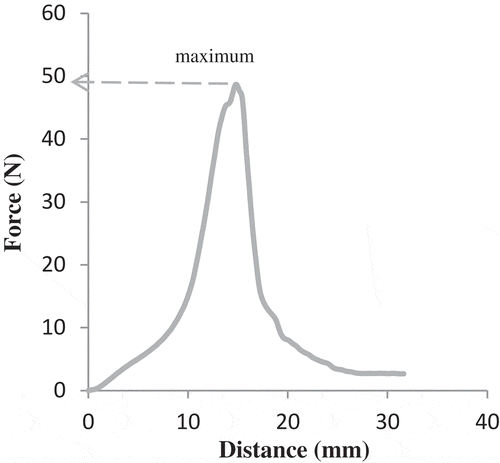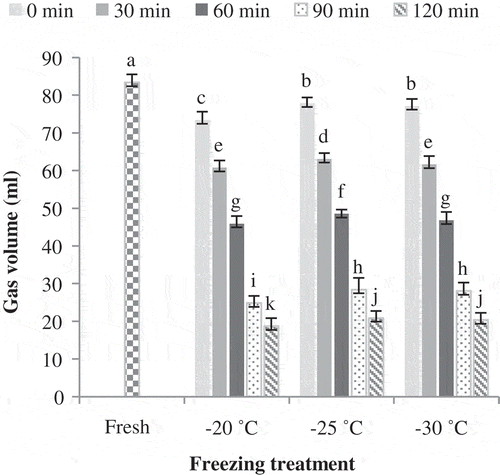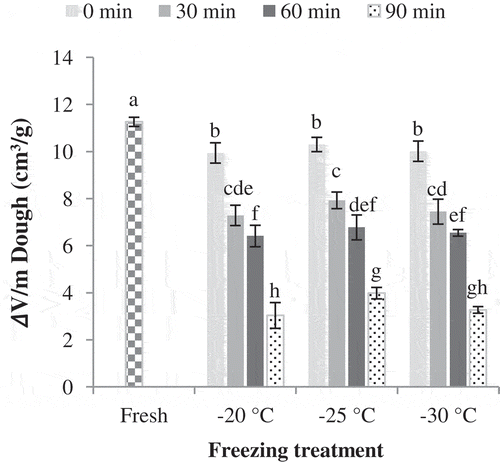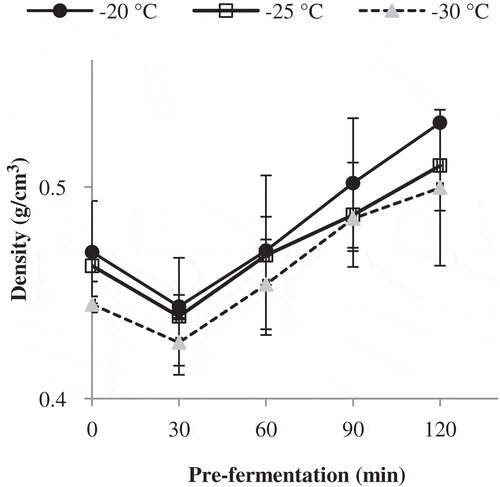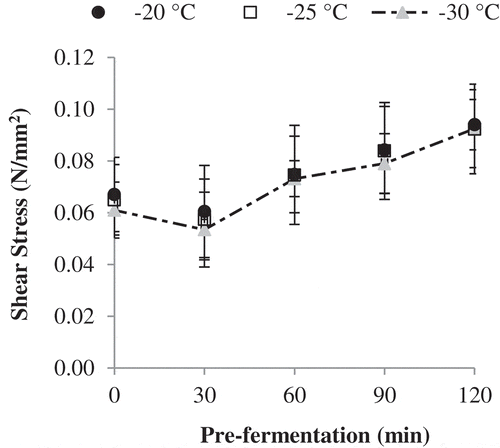ABSTRACT
The impact of pre-fermentation time and freezing rate on Sangak frozen dough and bread quality were studied. The pre-fermented doughs for 0, 30, 60, 90, or 120 min were frozen under –20, –25, or –30°C in air blast freezer. After 24 h storage at –18°C, dough samples were baked after final fermentation. The yeast viability, gassing power, and dough development for fresh and frozen Sangak doughs were determined. Crust color, density, and shear stress of bread obtained from fresh and frozen Sangak dough were evaluated. The results showed that yeast survival initially increased and then decreased with increasing freezing rate. The maximum yeast survival was observed at short pre-fermentation (30 min). A direct relationship was observed between gassing power, dough development, and yeast viability. From bread quality point-of-view, short pre-fermentation and higher freezing rate led to a more desirable bread.
Introduction
Bread and other cereal-based products play an important role in a well-balanced diet. Fresh bread has a short shelf life and its acceptability by consumer dramatically would reduce by increasing time between baking and consumption. Frozen dough technology makes possible to access fresh bread at any time of the day with reducing the equipment and labor costs. The growth of frozen dough market in last few decades proves advantages of this technology. Frozen dough is divided into unfermented and pre-fermented frozen dough based on the freezing before or after pre-fermentation, respectively. Dough quality as a food system containing living cell could be decrease due to stresses imposed during freezing and subsequent storage.[Citation1] The reduction of yeast population and gluten network damages caused during freezing process can be result in a quality loss of final product made from frozen dough.[Citation2] Among the factors affecting frozen dough quality, freezing rate is one of the main processing parameters that influences both yeast viability and gluten network integrity. Previous works showed that the baker’s yeast cells are better preserved with slower freezing rate in comparison to cryogenic freezing conditions. Nevertheless, higher freezing rate restricts crystal ice size, which is one of the main factors affecting food quality during freezing. Rasanen et al.[Citation3] have reported that a short pre-fermentation time in frozen dough enhanced their stability during freezing and thawing. Le-Bail et al.[Citation4] studied the effect of the degree of pre-fermentation in frozen dough and suggested a short fermentation before freezing. In contrast, several researchers reported that the pre-fermentation due to reduction in freeze tolerance of yeast had the adverse influence on product quality.[Citation5,Citation6] Takano et al.[Citation7] showed that effect of pre-fermentation depended on baker’s yeast strain. They reported that 1 h fermentation before freezing increased specific volume of bread using freeze tolerant yeast, while these treatments decreased bread volume using freeze sensible yeast. There are many other factors that affect the freezing tolerance of yeast cell such as nutritional status, moisture content and the presence of protective compounds such as trehalose in the dough.[Citation8,Citation9] Dough recipe, frozen storage duration, and thawing rate are also affecting parameters of frozen dough quality.[Citation10–Citation13]
The review of scientific literature shows that there are limited studies on the theme of pre-fermented frozen dough systems. Especially in frozen dough formulation, several factors such as water content still have not been fully investigated. The high proportion of water in dough could significantly affect its characteristics. To our knowledge, no previous researches have studied combination of freezing rate and pre-fermentation on the quality of bread produced from frozen dough with high water proportion. In this research, a dough with high water proportion (Iranian Sangak bread) has been selected as a test product. Sangak bread is one of the most widely used flat bread in Iran. This study is mainly focusing on the impact of the pre-fermentation degree and of the freezing rate on pre-fermented Sangak dough and bread quality. The frozen dough properties were evaluated based on the yeast viability after freezing and the activity of yeast during proofing. The bread properties were evaluated based on the density, firmness, and crust color in the final breads.
Materials and methods
Dough preparation
Sangak dough was prepared with 100 g wheat flour (13.20% moisture content, 13.70% protein, and 1.01% ash), 100 g water, 1 g salt, and 1 g baker’s dry yeast. The ingredients were mixed in a dough mixer for 4 min at low speed and for 6 min at high speed (HOBART, C-100, USA). After pre-fermentation, the dough was divided into 70 ± 1 g pieces and formed in circular flat shape with 6 mm thickness and 10 cm diameter by the mold.
Freezing, thawing, and fermentation condition
Pre-fermentation was carried out 0, 30, 60, 90, or 120 min in a proofing chamber at 30°C with 80% relative humidity (RH). After pre-fermentation and forming, freezing was done in an air blast freezer (GROUC, Iran) with air velocity of 2 m/s at –20, –25, or –30°C. Based on the definition of International Institute of Refrigeration[Citation14] and according to Le Bail et al.[Citation11] the freezing rate was between 1.20, 1.84, and 2.57°C/min, at –20, –25, or -30°C, respectively.
The dough was removed from the freezer when the dough center temperature reached –18°C. Frozen dough samples were packaged in polyethylene bags and stored at –18°C for 1 day. Then, frozen dough was withdrawn and placed in can (diameter: 10 cm). Finally, thawing and final fermentation of dough were done in fermentation chamber (30°C and 80% RH). The corresponding final fermentation times were 120, 90, 60, or 0 min, thus total time of the first and final fermentation was 120 min (full proving time). Final fermentation time was accounted from the beginning of dough expansion after thawing.
Bread baking
After final fermentation, dough samples were removed from can and placed in baking mold with 5 mm thickness and 10 cm diameter. Then the mold containing dough was placed in a forced convection oven (BOSCH, HBA73B550, Germany) for baking at 250°C for 10 min. After baking, bread samples were withdrawn from mold and allowed to cool for 15 min at 25°C.
Yeast survival analysis
Yeast viability was measured using the AACC method 42-50.[Citation15] Ten grams of the sample (obtained from different parts of the dough piece) was homogenized with 90 mL of sterile 0.85% peptone solution for 2 min. Then, 0.5 mL aliquot from this dilution was cultured in triplicate on the potato dextrose agar (PDA), adjusted to pH 3.5 with tartaric acid. Inoculated petri plates were incubated at 25°C for 72 h to determine the yeast count. Finally, the result was expressed by colony-forming unit (CFU) per gram dough.
Dough volume determination
Height rise (ΔH) of the dough inside the can was measured at the beginning and the end of the final fermentation by ultrasound probe (PEPPERL FUCHS, UC2000-30GM-1UR2-V15, Germany) and the dough volume expansion (VE) was calculated by the following equation:
where sample diameter (d) was equal to internal can diameter.
Gas production measurement
The gassing power was measured on fresh and frozen dough according to the AACC method 89-01.[Citation15] Twenty grams of frozen dough were placed into a 500-mL glass vessel, capped, and then placed in a water bath at 30°C. The vessel was connected to a digital manometer by a hose. After thawing (about 15 min), gas pressure was logged during final fermentation. For fresh dough, the pressure measurement was carried out without thawing period. The pressure values were converted to volume of gas at standard barometric pressure.
Bread density and texture analysis
To determine the bread density, after weighing the sample, its volume was measured using the rapeseed replacement according to the AACC method 10-5.[Citation15] Bread instrumental texture was analyzed with a texture analyzer (TX. A, STM-20, Iran). The samples were subjected to a puncture test using the 12.8 mm diameter plunger (d’) and at the speed of 100 mm/min. Bread thickness (t) was measured with a digital caliper. The firmness curves (force versus distance) were plotted and the maximum force (F) required to punch the sample was extracted (). Finally, shear stress (SS) was calculated for each sample by the following equation:[Citation16]
Bread crust color
Color was measured using a digital imaging method applying a combination of a digital camera (Sony Cyber-Shot DSC-WX100, Japan), a computer, and graphic software.[Citation17] Accordingly, bread sample was placed into the lighting system (CIE source D65 lamps); image of the bread crust were taken and transferred to a personal computer for evaluating the crust color. Color space parameters were determined in L* (lightness), a* (redness-greenness), and b* (yellowness-blueness) by Adobe Photoshop 7.0 software in accordance with CIE Lab system.
Statistical analysis
The experiments were performed in a completely randomized design with three replications. Analysis of variance was carried out using the SAS statistical software release 6.12 (SAS Institute, Cray, NC). The least significant difference (LSD) test was performed on the treatments means data (p < 0.05).
Results and discussion
Dough properties
Yeast survival
shows the effect of freezing rate and pre-fermentation time on yeast survival of Sangak dough. It can be seen that yeast viability of frozen doughs significantly (p < 0.05) was decreased in comparison with unfrozen dough (control). Damage to yeast cells in frozen doughs relative to control was about 13.3–81.5% as a function of freezing rate and pre-fermentation time. Yeast cells may be injured during freezing by physical factors such as ice crystal formation and dehydration.[Citation18,Citation19] Under certain conditions, outflow of water from the cell, related to increase in extracellular osmotic pressure and the membrane-lipid phase transition, can cause cell death.[Citation20] Heat stress and osmotic stress are two kind of stresses which are imposed simultaneously on yeast cells during cooling.[Citation21] It is also thought that oxidative stress may play a role in injury to the cell during freezing and thawing.[Citation22] shows that the yeast survival has improved at 30 min pre-fermentation. It seems that freeze tolerance of the yeast increases with a short pre-fermentation time. But then, the yeast survival gradually decreased with increasing the pre-fermentation time. It could be attributed to changes in ethanol content made by yeast during fermentation and or changes in the content of cryoprotectant compounds such as trehalose. The ethanol concentration in dough increases with increasing the fermentation time. The increase of ethanol concentration after 30 min pre-fermentation may act as an additional stress imposed on the yeast during freezing that resulted in more reduction of the yeast survival. Lewis et al.[Citation23] reported that under slow freezing ethanol led to lower viability than control, however under high freezing rate (200°C/min) it shows a cryoprotective effect on yeast cells.
Figure 2. Effect of freezing rate and pre-fermentation time on yeast survival (%) of Sangak dough. Different letters in each type of freezing conditions indicate significant differences (p < 0.05).
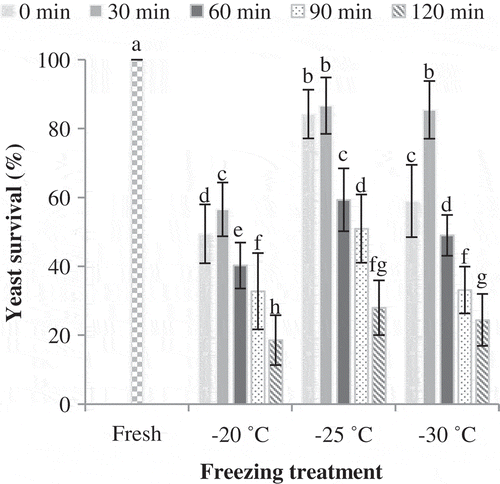
Also it can be seen that the yeast survival increased with decreasing the freezing temperature from –20 to –25°C, but then it decreased with more reduction of freezing temperature to –30°C (). This result, in agreement with those of Hsu et al.,[Citation5] indicates that the increase in freezing rate does not always increase the yeast’s survival. During freezing, the osmotic pressure increases in extracellular environment due to ice crystal formation. The increase of osmotic pressure causes the water to diffuse across the cell membrane. In slow freezing rate, the intracellular water will have enough time to flow out by osmosis and so due to outflow of water from the cell, yeast cells lose the intracellular water and become dehydrated and eventually die.[Citation18,Citation24] High freezing rate do not permit water transfer into extracellular medium; cells will not be able to maintain balance and eventually resulting in the formation of intracellular ice crystal.[Citation18,Citation25] Accordingly, it seems that main reason for death of yeast cells during slow and rapid freezing rate is due to dehydration and formation of intracellular ice crystal, respectively. Meziani et al.[Citation26] showed this phenomenon by electron microscopy studies.
Gas production
Gas production in dough is a key parameter for bread quality. presents the effect of freezing rate and pre-fermentation time on gas production of fresh and frozen Sangak dough after final fermentation. There was a significant decrease in gassing power of frozen dough samples in comparison with fresh dough. The unfrozen dough produced 83.4 ± 2.11 mL CO2 after 120 min of proofing. The highest gas volume obtained for frozen doughs for all pre-fermentation times at the freezing temperature of –25°C. While the lowest amount of CO2 produced in the frozen dough at –20°C. The trends in gas production ability showed a similarity to yeast viability results. These results are in agreement with the results of Havet et al.[Citation27] They reported that colony counting of yeast tended to confirm the results obtained from CO2 volume measurement. The gassing power of frozen dough depends on the quantity of yeast cells.[Citation28,Citation29] Also it can be seen that the gas production decreases as a function of pre-fermentation time (); by considering the corresponding final fermentation time, being shorter for more pre-fermentated samples, the decrease in gas production could be attributed to shorter final fermentation period. Moreover, the decrease in yeast survival with increasing pre-fermentation time () could be another reason for lower gas production of more pre-fermented samples.
Dough volume
shows the dough volume evolution during final fermentation as a function of freezing temperature and pre-fermentation. The results showed a significant decrease in the dough volume after freezing that based on previous works; it can be related to two main reasons: decrease of yeast viability and disruption of gluten network. The death of yeast during freezing which results in reduced gas production (as shown above) as well as release of reducing substances from dead yeast which disrupt gluten network,[Citation29] are reasons which is linked to the yeast death for poor dough expansion. Moreover, crystallization and recrystallization of ice in the freeze-thaw process causes physical damages to gluten network and disrupt its integrity that induces loss the gas retention capacity. Several studies observed a reduction in extensibility and maximum resistance to expansion of doughs subjected to freezing.[Citation30,Citation31] Esselink et al.[Citation32] displayed the collapse of gluten network in dough samples exposed to freezing and thawing by electron microscopy studies. Moreover the freezing rate has been shown an effect on dough expansion. shows that the highest and the lowest dough expansion obtained at –25 and –20°C freezing temperatures, respectively, for all the pre-fermentation times. In the case of freezing rate, the trend in dough expansion shows a similarity to yeast viability one; the maximum values obtained for the frozen samples at the freezing temperature of –25°C. These results suggest that yeast viability is a significant contributor to both gas production and dough expansion. As shown in , the decrease of final fermentation time has explained dough volume losses with longer pre-fermentation time.
Bread Quality
Bread density
The baking performance and bread quality are strongly related to the rheological properties of the dough[Citation33–Citation35] and to the yeast viability[Citation36] affected by different treatments such as freezing. The effect of freezing rate and pre-fermentation on density of bread made from Sangak frozen doughs are presented in . All breads made from frozen dough had higher density than control. The density of bread made from fresh dough was 0.41 ± 0.01 g/cm3. These results confirm that freezing affects the bread volume. Also it can be observed that the bread density as the yeast survival of dough has improved at 30 min pre-fermentation. But then, the bread density gradually increased with increasing the pre-fermentation time. It indicates that short pre-fermentation time has increased the bread volume. This observation is in agreement with the reported results by Rasanen et al.[Citation3] As shown in , the bread density decreased with the higher freezing rate although there was no significant difference between different freezing rates. It is in agreement with the results of Le-Bail et al.[Citation4] that reported the highest bread volume was obtained with the highest freezing rate. Phimolsiripol et al.[Citation37] reported that the higher freezing rate due to formation of small ice crystal preserves the rheological properties of gluten network. It seems that the role of gluten integrity in density of breads made from frozen dough is more than of the yeast viability.
Bread SS
A force-distance curve obtained from puncture test on frozen dough bread is shown in . As shown in Eq. (2), the SS depends on peak force applied to punch. Texture properties in bakery product can be a valuable parameter to control the product quality and optimize the process. Low bread SS is a desirable quality characteristic. The texture analysis results, expressed as SS, are presented in . The SS of bread made from fresh dough was 0.039 ± 0.002 N/mm2. All bread samples made from frozen dough had a higher SS in comparison with the control as the bread density. It indicates that the freezing also affects bread texture. The similarity of trends between density and SS can be attributed to the texture compression. Bread with a more compact texture will have a higher SS. Indeed, the volume increase makes thinner the gas cell wall and accordingly the force required to punch the bread decreases.
Crust color
Crust color is an important characteristic of baked products.[Citation38] The crust color values of the bread samples made from fresh and frozen doughs produced at different freezing temperatures and pre-fermentation times are shown in . Lightness (L*) in all breads made from frozen dough was lower than from fresh dough, except the bread made from unfermented frozen dough at –30°C. The L* values decreased with increasing pre-fermentation time. But, the observed difference was only significant between 0 and 120 min pre-fermentation. Also, it can be seen that lightness tended to increase as a function of freezing rate. These results show that the lightness of bread crust reduces with longer pre-fermentation time and slower freezing rate. The a* values showed less variation than two other color parameters. There was no significant difference between a* values of treatments. Although the b* values of bread crust made from fresh dough was higher than frozen dough samples, but a clear trend was not observed as a function of pre-fermentation time and freezing rate.
Table 1. Crust color values of bread made from fresh and frozen dough produced at different freezing temperatures and pre-fermentation times.
Conclusion
The aim of this work was to investigate the influence of pre-fermentation and freezing temperature on fermentative activity and baking properties of Sangak frozen dough. Frozen samples showed a reduction in yeast population, CO2 production and dough development in comparison with control. Freezing also increased the density and SS and decreased crust lightness of bread prepared from frozen dough. There was a direct relationship between density and SS. A short pre-fermentation for 30 min had an improving effect on yeast viability, bread density and firmness whereas the lowest yeast population and the highest bread density and SS were obtained in 120 min pre-fermentation. Among freezing temperatures, the highest yeast survival, CO2 production and dough development were achieved at –25°C. Baking properties of Sangak frozen dough affected by freezing rate. Density, firmness, and crust lightness of bread increased with decreasing freezing temperature. Based on our results, it can be concluded that the pre-fermentation had a more important effect on baking properties of bread than freezing rate.
Funding
This work has been supported by Center for International Scientific Studies & Collaboration (CISSC) and French Embassy in Tehran; the project is named Sangak Science (number 25613QB) under PHC GUNDISHAPUR 2011.
Additional information
Funding
References
- Van den Berg, L. Physicochemical Changes in Foods During Freezing and Subsequent Storage. In Recent Advances in Food Science; Hawthorn, J.; Rolfe, E.J.; Eds.; Pergamon Press: Oxford, 1968; pp. 205–219.
- Nakamura, T.; Takagi, H.; Shima, J. Effects of Ice-Seeding Temperature and Intracellular Trehalose Contents on Survival of Frozen Saccharomyces Cerevisiae Cells. Cryobiology 2009, 58, 170–174.
- Rasanen, J.; Harkonen, H.; Autio, K. Freeze–Thaw Stability of Prefermented Frozen Lean Wheat Doughs: Effect of Flour and Fermentation Time. Cereal Chemistry 1995, 72, 637–642.
- Le-Bail, A.; Nicolitch, C.; Vuillod, C. Fermented Frozen Dough: Impact of Pre-Fermentation Time and of Freezing Rate for a Pre-Fermented Frozen Dough on Final Volume of the Bread. Food and Bioprocess Technology 2010, 3, 197–203.
- Hsu, K.H.; Hoseney, R.C.; Seib, P.A. Frozen Dough. 1. Factors Affecting Stability of Yeasted Doughs. Cereal Chemistry 1979, 56, 419–424.
- Van Dijck, P.; Colavizza, D.; Smet, P.; Thevelein, J.M. Differential Importance of Trehalose in Stress Resistance in Fermenting and Nonfermenting Saccharomyces Cerevisiae Cells. Applied and Environmental Microbiology 1995, 61, 109–115.
- Takano, H.; Naito, S.; Ishida, N.; Koizumi, M.; Kano, H. Fermentation Process and Grain Structure of Baked Breads from Frozen Dough Using Freeze-Tolerant Yeasts. Journal of Food Science 2002, 67, 2725–2733.
- Macleod, R.A.; Calcot, P.H. Cold Shock and Freezing Damage to Microbe. In The survival of Vegetative Microbes; Gray, T.R.G.; Postgat, J.R.; Eds.; Cambridge University Press: Cambridge, MA, 1976; pp. 81–109.
- Lorenz, K.; Bechtel, W. Frozen Bread Dough. Bakers Digest 1964, 38, 59–60.
- Mazur, P.; Schmidt, J.J. Interactions of Cooling Velocity, Temperature, and Warming Velocity on the Survival of Frozen and Thawed Yeast. Cryobiology 1968, 5, 1–17.
- Le Bail, A.; Havet, M.; Pasco, M. Influence of the Freezing Rate and of Storage Duration on the Gassing Power of Frozen Bread Dough. In Hygiene, Quality and Safety in the Cold Chain and Air Conditioning; International Institute of Refrigeration: France, 1998; pp. 181–188.
- Lu, W.; Grant, L. Effects of Prolonged Storage at Freezing Temperatures on Starch and Baking Quality of Frozen Doughs. Cereal Chemistry 1999, 76, 656–662.
- Rouille, J.; Le Bail, A.; Courcoux, P. Influence of Formulation and Mixing Conditions on Breadmaking Qualities of French Frozen Dough. Journal of Food Engineering 2000, 43, 197–203.
- International Institute of Refrigeration. Recommendation for the Processing and Handling of Frozen Foods; International Institute of Refrigeration: Paris, France. 1986, 32–39.
- AACC. Approved Methods of the American Association of Cereal Chemists, 10th Ed; AACC: St. Paul, MN, 2000.
- Ahmed, E.M.; Martin, F.G.; Fluck, R.C. Damaging Stresses to Fresh and Irradiated Citrus Fruits. Journal of Food Science 1973, 38, 230–233.
- Yam, K.L.; Papadakis, S.E. A Simple Digital Imaging Method for Measuring and Analyzing Color of Food Surfaces. Journal of Food Engineering 2004, 61, 137–142.
- Mazur, P. Cryobiology—Freezing of biological systems. Science 1970, 168, 939–949.
- Mazur, P. Kinetics of Water Loss from Cells at Subzero Temperatures and the Likelihood of Intracellular Freezing. Journal of Genetic Physiology 1963, 47, 347–369.
- Dumont, F.; Marechal, P.A.; Gervais, P. Influence of Cooling Rate on 1-Saccharomyces Cerevisiae 2—Destruction During Freezing: Unexpected Viability at Ultra-Rapid Cooling Rates. Cryobiology 2003, 46, 33–42.
- Morris, G.; Coulson, G.; Clarke, K. Freezing Injury in Saccharomyces Cerevisiae: The Effect of Growth Conditions. Cryobiology 1988, 25, 471–482.
- Park, J.I.; Grant, C.M.; Davies, M.J.; Dawes, I.W. The Cytoplasmic Cu, Zn, Superoxide Dismutase of Saccharomyces Cerevisiae is Required for Resistance to Freeze-Thaw Stress: Generation of Free Radicals During Freezing and Thawing. Journal of Biological Chemistry 1998, 273, 22921–22928.
- Lewis, J.G.; Learmonth, R.P.; Watson, K. Role of Growth Phase and Ethanol in Freeze-thaw Stress Resistance of Saccharomyces Cerevisiae. Applied and Environmental Microbiology 1993, 59, 1065–1071.
- Beney, L.; Martinez de Maranon, I.; Marechal, P.A.; Gervais, P. Influence of Thermal and Osmotic Stresses on the Viability of the Yeast Saccharomyces Cerevisiae. International Journal of Food Microbiology 2000, 55, 275–279.
- Muldrew, K.; McGann, L.E. Mechanisms of Intracellular Ice Formation. Biophysical Journal 1990, 57, 525–532.
- Meziani, S.; Ioannou, I.; Jasniewski, J.; Belhaj, N.; Muller, J.M.; Ghoul, M.; Desobry, S. Effects of Freezing Treatments on the Fermentative Activity and Gluten Network Integrity of Sweet Dough. LWT–Food Science and Technology 2012, 46, 118–126.
- Havet, M.; Mankai, M.; Le-Bail, A. Infuence of the Freezing Condition on the Baking Performances of French Frozen Dough. Journal of Food Engineering 2000, 45, 139–145.
- Autio, K.; Sinda, E. Frozen Doughs: Rheological Changes and Yeast Viability. Cereal Chemistry 1992, 69, 409–413.
- Wolt, M.J.; D’appolonia, B.L. Factors Involved in the Stability of Frozen Dough. I. The Influence of Yeast Reducing Compounds on Frozen-Dough Stability. Cereal Chemistry 1984, 61, 209–212.
- Varriano-Marston, E.; Hsu, K.H.; Mahdi, J. Rheological and Structural Changes in Frozen Dough. Bakers Digest 1980, 54, 32–34.
- Yi, J.; Kerr, W.L. Combined Effects of Freezing Rate, Storage Temperature and Time on Bread Dough and Baking Properties. LWT–Food Science and Technology 2009, 42, 1474–1483.
- Esselink, E.F.J.; Aalst, J.; Maliepaard, M.; Duynhoven, J.P.M. Long-Term Storage Effect in Frozen Dough by Spectroscopy and Microscopy. Cereal Chemistry 2003, 80, 396–403.
- Huang, H.; Kokini, J.L. Measurement of Biaxial Extensional Viscosity of Wheat Flour Doughs. Journal of Rheology 1993, 37, 879.
- Janssen, A.; Van Vliet, T.; Vereijken, J. Fundamental and Empirical Rheological Behaviour of Wheat Flour Doughs and Comparison with Bread Making Performance. Journal of Cereal Science 1996, 23, 43–54.
- Dobraszczyk, B.; Smewing, J.; Albertini, M.; Maesmans, G.; Schofield, J. Extensional Rheology and Stability of Gas Cell Walls in Bread Doughs at Elevated Temperatures in Relation to Breadmaking Performance. Cereal Chemistry 2003, 80, 218–224.
- Hohmann, S. Shaping up: The Response of Yeast to Osmotic Stress. In Yeast Stress Responses; Hohmann, S.; Mager, W.H.; Eds.; Springer: New York, NY, 1997; pp. 101–146.
- Phimolsiripol, Y.; Siripatrawan, U.; Tulyathan, V.; Cleland, D.J. Effects of Freezing and Temperature Fluctuations During Frozen Storage on Frozen Dough and Bread Quality. Journal of Food Engineering 2008, 84, 48–56.
- Zanoni, B.; Peri, C.; Bruno, D. Modelling of Browning Kinetics of Bread Crust During Baking. LWT–Food Science and Technology 1995, 28, 604–609.

